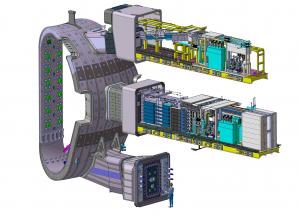Disruption mitigation

This model shows how the injectors for disruption mitigation, plus related equipment for cooling, vacuum pumping, and process gases, can be distributed at different levels of the vacuum vessel.
Disruptions are instabilities that may develop within the tokamak plasma and lead to the degradation or loss of the magnetic confinement of the plasma. Because of the high amount of energy contained within the plasma, the loss of confinement during a disruption can cause a significant thermal loading of in-vessel components, ultimately resulting in severe melting. In addition, high mechanical strains on other machine components risk reducing the lifetime of the entire tokamak.
ITER is planning a disruption mitigation system to cope with these potentially extremely damaging effects. The ITER disruption mitigation system is based on shattered pellet injection—a technique that delivers massive amounts of protium (hydrogen) and neon in the form of small ice fragments into the plasma from different toroidal locations to convert the stored thermal and magnetic energy into radiation. Cryogenic pellets the size of wine corks, and at a temperature of -268 °C, are accelerated to supersonic speeds (>1800 km/h) and shattered against an inclined surface so that they enter the 150 million-degree plasma as small broken fragments. The system acts on a time scale of milliseconds from the moment of the disruption detection to its mitigation.
An international task force working in three groups—Theory and Modelling, Experiments, and Technology—was formed in 2018 to focus on refining system design specifications and laying the foundation for the ITER design team to perform the corresponding engineering. As a result of this unique effort and collaboration, multiple protypes on various tokamaks and laboratories were developed and tested, culminating in the design of a sophisticated and robust mitigation system for ITER that passed its final design review in early 2024.
